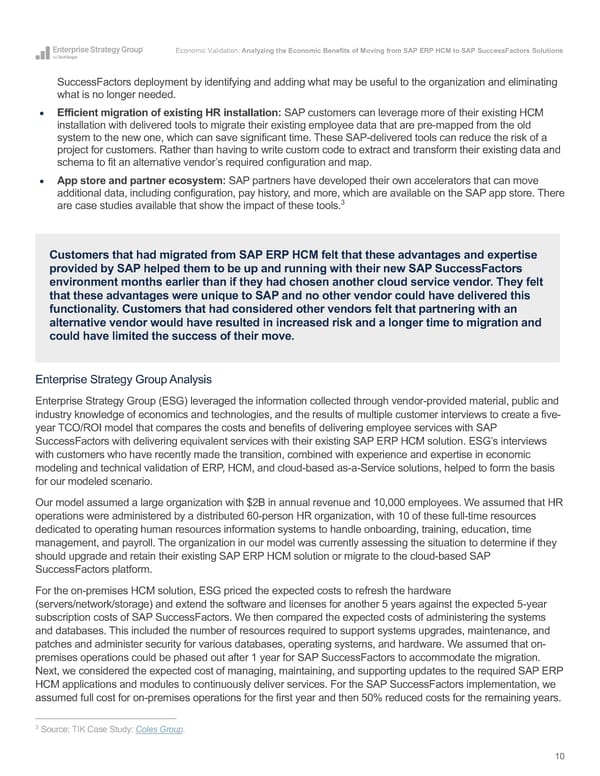Economic Validation: Analyzing the Economic Benefits of Moving from SAP ERP HCM to SAP SuccessFactors Solutions SuccessFactors deployment by identifying and adding what may be useful to the organization and eliminating what is no longer needed. • Efficient migration of existing HR installation: SAP customers can leverage more of their existing HCM installation with delivered tools to migrate their existing employee data that are pre-mapped from the old system to the new one, which can save significant time. These SAP-delivered tools can reduce the risk of a project for customers. Rather than having to write custom code to extract and transform their existing data and schema to fit an alternative vendor’s required configuration and map. • App store and partner ecosystem: SAP partners have developed their own accelerators that can move additional data, including configuration, pay history, and more, which are available on the SAP app store. There 3 are case studies available that show the impact of these tools. Customers that had migrated from SAP ERP HCM felt that these advantages and expertise provided by SAP helped them to be up and running with their new SAP SuccessFactors environment months earlier than if they had chosen another cloud service vendor. They felt that these advantages were unique to SAP and no other vendor could have delivered this functionality. Customers that had considered other vendors felt that partnering with an alternative vendor would have resulted in increased risk and a longer time to migration and could have limited the success of their move. Enterprise Strategy Group Analysis Enterprise Strategy Group (ESG) leveraged the information collected through vendor-provided material, public and industry knowledge of economics and technologies, and the results of multiple customer interviews to create a five- year TCO/ROI model that compares the costs and benefits of delivering employee services with SAP SuccessFactors with delivering equivalent services with their existing SAP ERP HCM solution. ESG’s interviews with customers who have recently made the transition, combined with experience and expertise in economic modeling and technical validation of ERP, HCM, and cloud-based as-a-Service solutions, helped to form the basis for our modeled scenario. Our model assumed a large organization with $2B in annual revenue and 10,000 employees. We assumed that HR operations were administered by a distributed 60-person HR organization, with 10 of these full-time resources dedicated to operating human resources information systems to handle onboarding, training, education, time management, and payroll. The organization in our model was currently assessing the situation to determine if they should upgrade and retain their existing SAP ERP HCM solution or migrate to the cloud-based SAP SuccessFactors platform. For the on-premises HCM solution, ESG priced the expected costs to refresh the hardware (servers/network/storage) and extend the software and licenses for another 5 years against the expected 5-year subscription costs of SAP SuccessFactors. We then compared the expected costs of administering the systems and databases. This included the number of resources required to support systems upgrades, maintenance, and patches and administer security for various databases, operating systems, and hardware. We assumed that on- premises operations could be phased out after 1 year for SAP SuccessFactors to accommodate the migration. Next, we considered the expected cost of managing, maintaining, and supporting updates to the required SAP ERP HCM applications and modules to continuously deliver services. For the SAP SuccessFactors implementation, we assumed full cost for on-premises operations for the first year and then 50% reduced costs for the remaining years. 3 Source: TIK Case Study: Coles Group. 10
 Analyzing the Economic Benefits of Moving from SAP ERP HCM to SAP SuccessFactors Solutions Page 9 Page 11
Analyzing the Economic Benefits of Moving from SAP ERP HCM to SAP SuccessFactors Solutions Page 9 Page 11